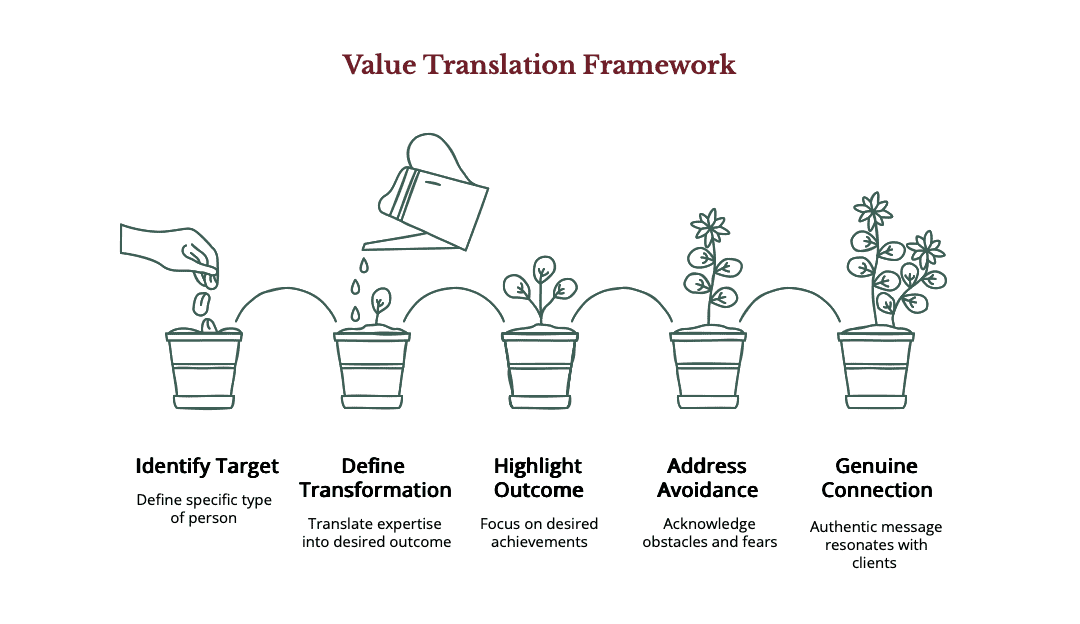Have you ever felt your stomach drop when someone asks what you do and you hear yourself say “I’m a consultant” or “I’m starting a creative business”? That moment when you know you sound like everyone else, despite having years of hard-won expertise and a unique approach that sets you apart?
You’re not alone. The problem isn’t that you don’t know what you do. It’s that the way we’re taught to introduce ourselves strips away everything that makes you valuable.
Why Generic Introductions Keep You Invisible
Here’s what’s actually happening when you default to standard business labels.
The commoditisation trap. Job titles turn your unique journey into something forgettable. Whether you say “consultant,” “coach,” or “creative,” you’ve just placed yourself in an overcrowded category where the only differentiator becomes price.
The nervous system cost. Something inside you withers when you hear yourself saying something that feels hollow. Your nervous system rebels against the performance, and everyone can feel the disconnect.
The wrong attraction. Generic introductions earn you that polite-but-distant smile that means ‘next conversation, please’. Or worse—they attract price-sensitive clients who see you as interchangeable with every other person using the same label.
You don’t need louder. You need clearer.
The depth of your experience, the specific way you solve problems, the particular transformation you help create—none of that comes through when you reduce yourself to a job title that could apply to thousands of other people.
Your Value Isn’t Hidden—It’s Just Not Translated
Here’s the thing: what makes you different already exists. You don’t need to manufacture uniqueness or create a persona. You need to translate what’s already true about your work into language that helps the right people recognise you.
Your existing assets matter more than you think. Your specific background—whether corporate, creative, technical, or a mix—shapes how you see problems differently. The particular transformation you help create isn’t just what you do; it’s how you do it, informed by everything you’ve learned along the way.
The translation challenge is real. Bridging the gap between knowing your worth and communicating it without sounding like a corporate robot feels impossible because most advice treats this like a marketing exercise. It’s not. It’s a clarity exercise.
This is where the Value Translation Framework comes in.
The 5-Step Value Translation Process
Here’s how to create your own Value Statement:
- Identify your specific person – Who exactly do you serve? (Not “small business owners” but “burned-out corporate professionals transitioning to freelance”)
- Define the transformation – What specific change do you help create? (Not “grow their business” but “turn their expertise into sustainable income”)
- Clarify their desired outcome – What do they actually want to achieve? (Freedom, meaningful work, financial stability)
- Name what they want to avoid – What obstacles are they trying to sidestep? (Starting from scratch, working with difficult clients, burnout)
- Test for authenticity – Does it feel true when you say it? Does it energize rather than drain you?
The framework: “I help [specific person] [achieve transformation] so they can [desired outcome] without [what they want to avoid].”
The Value Translation Framework
Instead of crafting clever marketing messages, this approach helps you translate what you actually do into words that create genuine connection.
The structure is simple:
“I help [specific type of person] [achieve specific transformation] so they can [desired outcome] without [what they want to avoid].”
Let’s break this down:
Specific type of person: Not “small business owners” but “mid-career professionals transitioning out of corporate.” Not “entrepreneurs” but “experienced managers who want to freelance.” The more specific, the more your ideal clients think “that’s me.”
Specific transformation: Not “grow their business” but “translate their corporate expertise into independent consulting.” Not “find success” but “create sustainable freelance income using skills they already have.”
Desired outcome: What they actually want to achieve or experience. Freedom, meaningful work, financial stability, creative control, time with family.
What they want to avoid: The obstacles, fears, or trade-offs they’re trying to sidestep. Starting from scratch, working with difficult clients, sacrificing their values, burning out.
How This Sounds in Practice
Here’s what happens when you stop hiding behind job titles and start speaking to what actually matters:
Food photographer (former office worker): “I help artisan bakers capture the soul of their creations so their customers feel the love before they even taste the bread – building devoted communities instead of competing with soulless chains that treat food like fuel.”
Business coach (escaped teacher): “I help crushed teachers reclaim their gift for transformation through online courses so they can impact lives on their terms without being trapped in a broken system that’s slowly killing their spirit.”
Web designer (former nurse): “I help healers create digital sanctuaries that feel like a warm embrace so their ideal clients find them effortlessly without drowning in a sea of generic wellness websites that all say the same empty things.”
Content strategist (corporate refugee): “I help brilliant coaches turn their wisdom into content that flows naturally so they can share their gifts consistently without feeling like a performing monkey dancing for the algorithm.”
Mindset coach (former number-cruncher): “I help creative souls stop apologising for their prices so they can honour the true value of their art without starving for their passion or selling their soul to pay the bills.”
Notice how each of these immediately tells you who they serve, what change they create, and why it matters—without sounding like everyone else in their field.
Transmission Over Performance
Here’s what changes when you have a clear Value Statement: the energy shift from performing to transmitting.
You’re no longer trying to convince anyone of anything and start communicating from genuine authority. This changes how you feel when you say it, and it changes how others respond.
In networking conversations, you’ll watch people’s eyes light up instead of glazing over with bored politeness. The right people will want to know more.
In online profiles, your bio becomes compelling because it reflects your actual expertise rather than generic industry language.
In client conversations, you build trust faster because you’re speaking clearly about real value rather than hiding behind vague professional terminology.
The sovereignty element matters here too. Your Value Statement should preserve your autonomy, not compromise it. You’re attracting aligned opportunities, not trying to appeal to everyone.
Beyond the Elevator Pitch

A clear Value Statement works differently. It helps the right people recognise themselves in what you’re saying. It’s less about persuasion and more about connection.
In practice, this means:
- Conversations that feel natural rather than rehearsed
- Attracting opportunities that align with your actual expertise
- Building authority through authenticity, not industry jargon
- Creating genuine interest rather than polite acknowledgment
Before You Start Overthinking This
Why do elevator pitches feel so awful? Because they’re performative nonsense designed to turn you into a walking advertisement. Your nervous system knows the difference between authentic communication and sales theater, and so does everyone listening.
What do I actually say at networking events? Lead with your Value Statement, then have a real conversation. Stop trying to “pitch” and start connecting with people who actually need what you offer. The right people will ask questions; the wrong people will politely excuse themselves. Both outcomes are perfect.
How do I know if this is actually working? You’ll feel the difference before you see it. When you’re speaking from truth instead of performance, your energy changes. You’ll stop feeling drained by these conversations and start feeling energized. Plus, you’ll watch people’s faces light up instead of glazing over with bored politeness.
What if it feels too specific? Good. Specific is what cuts through the noise. If you’re worried about excluding people, you’re probably still thinking like someone who needs to convince everyone instead of someone who serves the right people exceptionally well.
How long should this take to figure out? Stop overthinking it. Start with what feels most true right now and refine as you go. Perfectionism is just procrastination wearing a fancy outfit.
Start Where You Are
You don’t need to become someone else to communicate your value clearly. You need to get clearer about who you already are and what change you help create.
Try this: Think about the last time your work felt like breathing instead of suffocating. What transformation did you help create? Who were you serving? What made the difference you provided unique?
That’s your starting point for developing your own Value Statement using the Translation Framework.
Your value already exists. Now you just need to translate it into words that help the right people find you.





